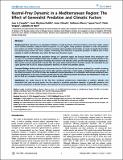Por favor, use este identificador para citar o enlazar a este item:
http://hdl.handle.net/10261/11537COMPARTIR / EXPORTAR:
 SHARE SHARE
 CORE
BASE CORE
BASE
|
|
| Visualizar otros formatos: MARC | Dublin Core | RDF | ORE | MODS | METS | DIDL | DATACITE | |

| Campo DC | Valor | Lengua/Idioma |
|---|---|---|
| dc.contributor.author | Fargallo, Juan A. | es_ES |
| dc.contributor.author | Martínez-Padilla, Jesús | es_ES |
| dc.contributor.author | Viñuela, Javier | es_ES |
| dc.contributor.author | Blanco, Guillermo | es_ES |
| dc.contributor.author | Torre, Ignasi | es_ES |
| dc.contributor.author | Vergara, Pablo | es_ES |
| dc.contributor.author | Neve, Liesbeth de | es_ES |
| dc.date.accessioned | 2009-03-12T12:12:37Z | - |
| dc.date.available | 2009-03-12T12:12:37Z | - |
| dc.date.issued | 2009-02-23 | - |
| dc.identifier.citation | PLoS ONE 4(2): e4311 (2009) | es_ES |
| dc.identifier.issn | 1932-6203 | - |
| dc.identifier.uri | http://hdl.handle.net/10261/11537 | - |
| dc.description.abstract | [Background] Most hypotheses on population limitation of small mammals and their predators come from studies carried out in northern latitudes, mainly in boreal ecosystems. In such regions, many predators specialize on voles and predator-prey systems are simpler compared to southern ecosystems where predator communities are made up mostly of generalists and predator-prey systems are more complex. Determining food limitation in generalist predators is difficult due to their capacity to switch to alternative prey when the basic prey becomes scarce. | es_ES |
| dc.description.abstract | [Methodology] We monitored the population density of a generalist raptor, the Eurasian kestrel Falco tinnunculus over 15 years in a mountainous Mediterranean area. In addition, we have recorded over 11 years the inter-annual variation in the abundance of two main prey species of kestrels, the common vole Microtus arvalis and the eyed lizard Lacerta lepida and a third species scarcely represented in kestrel diet, the great white-toothed shrew Crocidura russula. We estimated the per capita growth rate (PCGR) to analyse population dynamics of kestrel and predator species. | es_ES |
| dc.description.abstract | [Principal Findings] Multimodel inference determined that the PCGR of kestrels was better explained by a model containing the population density of only one prey species (the common vole) than a model using a combination of the densities of the three prey species. The PCGR of voles was explained by kestrel abundance in combination with annual rainfall and mean annual temperature. In the case of shrews, growth rate was also affected by kestrel abundance and temperature. Finally, we did not find any correlation between kestrel and lizard abundances. | es_ES |
| dc.description.abstract | [Significance] Our study showed for the first time vertebrate predator-prey relationships at southern latitudes and determined that only one prey species has the capacity to modulate population dynamics of generalist predators and reveals the importance of climatic factors in the dynamics of micromammal species and lizards in the Mediterranean region. | es_ES |
| dc.description.sponsorship | The Spanish Ministerio de Educación y Ciencia (Projects: CGL2004-04479/BOS and CGL2007-61395/BOS) financed the study over the last four years. | es_ES |
| dc.format | application/pdf | es_ES |
| dc.format.extent | 551235 bytes | - |
| dc.format.mimetype | application/pdf | - |
| dc.language.iso | eng | es_ES |
| dc.publisher | Public Library of Science | es_ES |
| dc.relation | info:eu-repo/grantAgreement/MEC//CGL2007-61395/ES/CAMBIOS AMBIENTALES Y RASGOS DE LOS CICLOS VITALES EN AVES DE LA PENINSULA IBERICA/ | es_ES |
| dc.relation.isversionof | Publisher's version | es_ES |
| dc.rights | openAccess | es_ES |
| dc.subject | Predators | es_ES |
| dc.subject | Small mammals | es_ES |
| dc.subject | Eurasian kestrel | es_ES |
| dc.subject | Falco tinnunculus | es_ES |
| dc.subject | Microtus arvalis | es_ES |
| dc.subject | Lacerta lepida | es_ES |
| dc.subject | Crocidura russula | es_ES |
| dc.subject | Per capita growth rate (PCGR) | es_ES |
| dc.subject | Population dynamics | es_ES |
| dc.subject | Mediterranean region | es_ES |
| dc.title | Kestrel-prey dynamic in a Mediterranean region: the effect of generalist predation and climatic factors | es_ES |
| dc.type | artículo | es_ES |
| dc.identifier.doi | 10.1371/journal.pone.0004311 | - |
| dc.description.peerreviewed | Peer reviewed | es_ES |
| dc.relation.publisherversion | http://dx.doi.org/10.1371/journal.pone.0004311 | es_ES |
| dc.rights.license | http://creativecommons.org/licenses/by/4.0/ | es_ES |
| dc.contributor.funder | Ministerio de Educación y Ciencia (España) | es_ES |
| dc.relation.csic | Sí | es_ES |
| dc.identifier.pmid | 19234618 | - |
| dc.type.coar | http://purl.org/coar/resource_type/c_6501 | es_ES |
| item.fulltext | With Fulltext | - |
| item.languageiso639-1 | en | - |
| item.openairecristype | http://purl.org/coar/resource_type/c_18cf | - |
| item.openairetype | artículo | - |
| item.cerifentitytype | Publications | - |
| item.grantfulltext | open | - |
| Aparece en las colecciones: | (MNCN) Artículos (IREC) Artículos | |
Ficheros en este ítem:
| Fichero | Descripción | Tamaño | Formato | |
|---|---|---|---|---|
| Fargallo_et_al_PLoS_ONE_2009.pdf | 538,32 kB | Adobe PDF |  Visualizar/Abrir |
CORE Recommender
PubMed Central
Citations
10
checked on 27-mar-2024
SCOPUSTM
Citations
51
checked on 24-abr-2024
WEB OF SCIENCETM
Citations
51
checked on 24-feb-2024
Page view(s)
445
checked on 24-abr-2024
Download(s)
332
checked on 24-abr-2024

